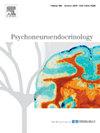Association of early pregnancy telomere length and mitochondrial copy number with gestational diabetes mellitus and depressive symptoms
IF 3.4
2区 医学
Q2 ENDOCRINOLOGY & METABOLISM
引用次数: 0
Abstract
Aim
A bidirectional link exists between depression and gestational diabetes mellitus (GDM). While telomere length (TL) and mitochondrial DNA copy number (mtDNA-CN) alterations have been reported either in GDM or depression, their predictive ability of GDM with coexisting depression remains unexplored. We, therefore, prospectively investigated the relationship of TL and mtDNA-CN in blood leukocytes during early pregnancy and explored their potential as predictive biomarkers for identifying the risk of developing GDM with depressive symptoms later in pregnancy.
Methods
A nested cohort of 301 women with normal fasting glucose and without depressive symptoms in early pregnancy (<16 weeks) were selected from the STratification of Risk of Diabetes in Early Pregnancy (STRiDE) study. At 24–28 weeks (OGTT visit), a 75 g OGTT and PHQ-9 were performed. Women were categorized into four groups: NGT without depressive symptoms (n = 80), NGT with depressive symptoms (n = 105), GDM without depressive symptoms (n = 75), and GDM with depressive symptoms (n = 41). Blood leukocyte TL and mtDNA-CN were assessed using qRT-PCR.
Results
TL and mtDNA-CN at early pregnancy were lower in women with GDM, depressive symptoms or both, compared to NGT without depressive symptoms at OGTT visit. TL and mtDNA-CN at early pregnancy were negatively associated with PHQ-9 score and OGTT blood glucose levels at OGTT visit after adjusting for age, pre-pregnancy BMI and family history of diabetes. Higher levels of both TL and mtDNA-CN in early pregnancy were associated with lower adjusted Relative Risk (aRR) (TL; aRR: 0.34; 95 % CI: 0.28, 0.41, mtDNA-CN; aRR: 0.83; 95 % CI: 0.74, 0.93) of GDM with depressive symptoms at OGTT visit.
Conclusion
Lower levels of TL and mtDNA-CN in early pregnancy are significantly associated with the later development of GDM and depressive symptoms at OGTT visit. Our findings indicate that early trimester TL and mtDNA-CN could be potential predictive biomarkers for predicting GDM with depressive symptoms and emphasize their potential for improved risk assessment so as to adopt preventive strategies targeting these conditions.
妊娠早期端粒长度和线粒体拷贝数与妊娠期糖尿病和抑郁症状的关系
抑郁症与妊娠期糖尿病(GDM)存在双向联系。虽然端粒长度(TL)和线粒体DNA拷贝数(mtDNA-CN)的改变在GDM或抑郁症中都有报道,但它们对GDM合并抑郁症的预测能力仍未得到探索。因此,我们前瞻性地研究了妊娠早期血液白细胞中TL和mtDNA-CN的关系,并探讨了它们作为妊娠后期发展为GDM伴抑郁症状风险的预测性生物标志物的潜力。方法选择妊娠早期(16周)空腹血糖正常、无抑郁症状的301例妊娠早期(16周)妇女为巢式队列。在24-28周(OGTT访问),进行75 g OGTT和PHQ-9。将女性分为四组:无抑郁症状的NGT (n = 80)、有抑郁症状的NGT (n = 105)、无抑郁症状的GDM (n = 75)和有抑郁症状的GDM (n = 41)。采用qRT-PCR检测血液白细胞TL和mtDNA-CN。结果与无抑郁症状的NGT相比,GDM、抑郁症状或两者兼有的妊娠早期stl和mtDNA-CN较低。在调整年龄、孕前BMI和糖尿病家族史后,妊娠早期TL和mtDNA-CN与OGTT访视时PHQ-9评分和OGTT血糖水平呈负相关。妊娠早期较高水平的TL和mtDNA-CN与较低的调整相对危险度(aRR)相关(TL;加勒比海盗:0.34;95 % CI: 0.28, 0.41, mtDNA-CN;加勒比海盗:0.83;95 % CI: 0.74, 0.93)在OGTT访问时GDM伴抑郁症状。结论妊娠早期较低的TL和mtDNA-CN水平与GDM的后期发展及OGTT访视时的抑郁症状显著相关。我们的研究结果表明,妊娠早期TL和mtDNA-CN可能是预测GDM伴抑郁症状的潜在预测性生物标志物,并强调它们在改善风险评估方面的潜力,从而采取针对这些疾病的预防策略。
本文章由计算机程序翻译,如有差异,请以英文原文为准。
求助全文
约1分钟内获得全文
求助全文
来源期刊

Psychoneuroendocrinology
医学-精神病学
CiteScore
7.40
自引率
8.10%
发文量
268
审稿时长
66 days
期刊介绍:
Psychoneuroendocrinology publishes papers dealing with the interrelated disciplines of psychology, neurobiology, endocrinology, immunology, neurology, and psychiatry, with an emphasis on multidisciplinary studies aiming at integrating these disciplines in terms of either basic research or clinical implications. One of the main goals is to understand how a variety of psychobiological factors interact in the expression of the stress response as it relates to the development and/or maintenance of neuropsychiatric illnesses.
 求助内容:
求助内容: 应助结果提醒方式:
应助结果提醒方式:


